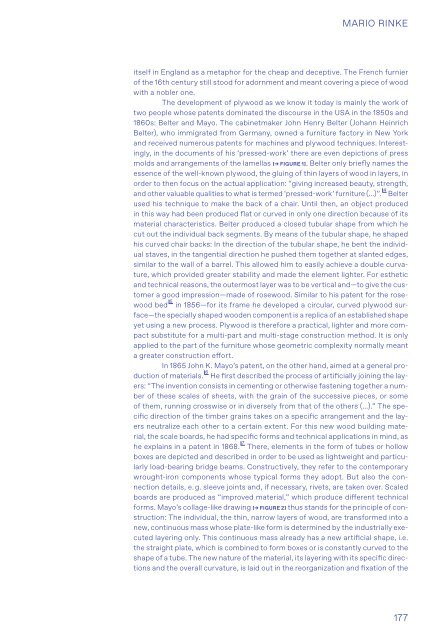Formful Wood. Explorative Furniture
ISBN 978-3-86859-588–8 https://www.jovis.de/de/buecher/product/formful-wood-explorative-furniture.html
ISBN 978-3-86859-588–8
https://www.jovis.de/de/buecher/product/formful-wood-explorative-furniture.html
You also want an ePaper? Increase the reach of your titles
YUMPU automatically turns print PDFs into web optimized ePapers that Google loves.
MARIO RINKE<br />
itself in England as a metaphor for the cheap and deceptive. The French furnier<br />
of the 16th century still stood for adornment and meant covering a piece of wood<br />
with a nobler one.<br />
The development of plywood as we know it today is mainly the work of<br />
two people whose patents dominated the discourse in the USA in the 1850s and<br />
1860s: Belter and Mayo. The cabinetmaker John Henry Belter (Johann Heinrich<br />
Belter), who immigrated from Germany, owned a furniture factory in New York<br />
and received numerous patents for machines and plywood techniques. Interestingly,<br />
in the documents of his ‘pressed-work’ there are even depictions of press<br />
molds and arrangements of the lamellas [→ FIGURE 1]. Belter only briefly names the<br />
essence of the well-known plywood, the gluing of thin layers of wood in layers, in<br />
order to then focus on the actual application: “giving increased beauty, strength,<br />
and other valuable qualities to what is termed ‘pressed-work’ furniture (…)”. 4 Belter<br />
used his technique to make the back of a chair. Until then, an object produced<br />
in this way had been produced flat or curved in only one direction because of its<br />
material characteristics. Belter produced a closed tubular shape from which he<br />
cut out the individual back segments. By means of the tubular shape, he shaped<br />
his curved chair backs: In the direction of the tubular shape, he bent the individual<br />
staves, in the tangential direction he pushed them together at slanted edges,<br />
similar to the wall of a barrel. This allowed him to easily achieve a double curvature,<br />
which provided greater stability and made the element lighter. For esthetic<br />
and technical reasons, the outermost layer was to be vertical and—to give the customer<br />
a good impression—made of rosewood. Similar to his patent for the rosewood<br />
bed 5 in 1856—for its frame he developed a circular, curved plywood surface—the<br />
specially shaped wooden component is a replica of an established shape<br />
yet using a new process. Plywood is therefore a practical, lighter and more compact<br />
substitute for a multi-part and multi-stage construction method. It is only<br />
applied to the part of the furniture whose geometric complexity normally meant<br />
a greater construction effort.<br />
In 1865 John K. Mayo’s patent, on the other hand, aimed at a general production<br />
of materials. 6 He first described the process of artificially joining the layers:<br />
“The invention consists in cementing or otherwise fastening together a number<br />
of these scales of sheets, with the grain of the successive pieces, or some<br />
of them, running crosswise or in diversely from that of the others (…).” The specific<br />
direction of the timber grains takes on a specific arrangement and the layers<br />
neutralize each other to a certain extent. For this new wood building material,<br />
the scale boards, he had specific forms and technical applications in mind, as<br />
he explains in a patent in 1868. 7 There, elements in the form of tubes or hollow<br />
boxes are depicted and described in order to be used as lightweight and particularly<br />
load-bearing bridge beams. Constructively, they refer to the contemporary<br />
wrought-iron components whose typical forms they adopt. But also the connection<br />
details, e. g. sleeve joints and, if necessary, rivets, are taken over. Scaled<br />
boards are produced as “improved material,” which produce different technical<br />
forms. Mayo’s collage-like drawing [→ FIGURE 2] thus stands for the principle of construction:<br />
The individual, the thin, narrow layers of wood, are transformed into a<br />
new, continuous mass whose plate-like form is determined by the industrially executed<br />
layering only. This continuous mass already has a new artificial shape, i.e.<br />
the straight plate, which is combined to form boxes or is constantly curved to the<br />
shape of a tube. The new nature of the material, its layering with its specific directions<br />
and the overall curvature, is laid out in the reorganization and fixation of the<br />
177


















